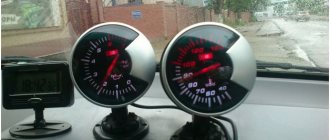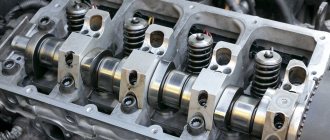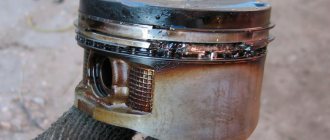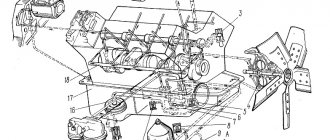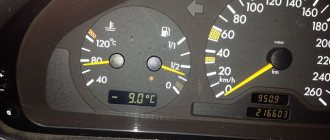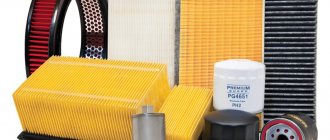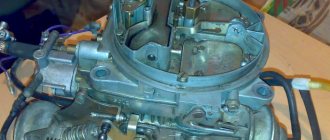Why does the light bulb come on?
Sometimes the on-board computer can duplicate the fault message and also provide more detailed information
There are several reasons why the light comes on. Below we will look at the most common ones. In all situations, the problem may be related to a malfunction of the pressure/oil level sensor, which indicates a problem with pressure in a diesel and gasoline engine.
At idle
If the oiler does not go out after starting the engine, we advise you to immediately check the oil pressure. Most likely, the oil pump has failed (or is starting to fail).
While driving (at high speeds)
The oil pump cannot produce the required pressure under heavy load. The reason may also be the driver’s desire to drive fast. Many engines “eat” oil at high speeds. When checking with a dipstick, the lack of oil is not noticed, but for electronics, a sharp drop in the level, even by 200 grams, is a very important “event”, which is why the lamp lights up.
After changing the oil
It also happens that the engine oil seems to have been changed, but the oil can still lights up. The most logical reason is that oil is leaving the system. If everything is fine and it does not leave the system, then you should check. The problem may also be with the pressure in the system.
Cold
A malfunction may occur if oil with an inappropriate viscosity for the engine is filled. At first it is thick and it is difficult for the pump to pump it through the system, but after warming up it becomes more liquid and normal pressure is created - as a result, the lamp goes out.
On a hot engine
If, after warming up the engine, the oil can remains on, this may indicate several reasons. The first is the rather low level/pressure of the oil itself; the second is an oil of unsuitable viscosity; the third is wear of the lubricant.
Mono-supplements in capsules
Capsulated inositol is an ideal option for maintaining a healthy body. Most supplements do not contain very high dosages, but they are sufficient to prevent deficiency. Under heavy loads, you need to choose more concentrated dietary supplements with vitamin B8.
№5 Solgar Inositol 500 mg
- Country: USA.
- The number of capsules in the package is 100 pcs.
- Concentration - 500 mg.
- Daily dosage - 1 pc.
The manufacturer Solgar has released an inositol supplement that can be taken by vegetarians. The dietary supplement does not contain dyes, sweeteners or flavors. Each capsule contains an optimal concentration of vitamin B8; it is ideal for maintaining health during periods of stress. The dietary supplement is useful for men and women planning a child, as well as for people with diabetes and liver or heart disease.
Pros:
- normalizes the menstrual cycle;
- has a beneficial effect on the female reproductive system, especially on the ovaries;
- helps cope with stress;
- supports the body in the treatment of diabetes;
- balances hormonal levels.
Minuses:
Some experienced sleep problems while taking it: insomnia, nightmares.
№4 Nature's Way Inositol 500 mg
- Country: USA.
- The number of capsules in the package is 100 pcs.
- Concentration - 500 mg.
- Daily dosage - 1 pc.
The right inositol supplement helps maintain health at the molecular level. The substance is part of cell membranes and is responsible for the normal transmission of nerve impulses. Dietary supplement from the manufacturer Nature's Way perfectly helps improve brain function during mental stress. Doctors recommend taking dietary supplements for diabetes mellitus, problems with the female reproductive system and liver diseases. And taking a course of vitamin B8 on time will increase the likelihood of getting pregnant.
Pros:
- reduces appetite and helps lose weight;
- reduces nervous tension;
- improves brain function;
- helps with polycystic ovary syndrome and other women's problems;
- recommended when planning pregnancy.
Minuses:
The result is cumulative and not immediately noticeable.
№3 Jarrow Formulas Inositol
- Country: USA.
- The number of capsules in the package is 100 pcs.
- Concentration - 750 mg.
- Daily dosage - 1 pc.
The inositol content in this supplement is slightly higher than its analogues. This dietary supplement is recommended for women to take when treating problems with the pelvic organs. Vitamin B8 controls the normal transmission of nerve impulses from the brain to the liver and muscles, so Inositol will help well with liver diseases or increased stress.
The tablets are made entirely from plant ingredients and are therefore suitable for vegans.
Pros:
- good for liver health;
- does not contain allergens;
- improves fertility well;
- increased dosage of myo-inositol.
Minuses:
may cause headache.
№2 Now Foods Inositol Capsules
- Country: USA.
- The number of capsules in the package is 100 pcs.
- Concentration - 500 mg.
- Daily dosage - 1 pc.
The product also contains myo-inositol. This isomer is considered the most effective, so dietary supplements are great for combating deficiency. It is recommended to take the dietary supplement Inositol Capsules for heart problems, increased stress, diabetes mellitus, and a sharp decrease in vision. It will help maintain the health of the body at the cellular level, having a beneficial effect on vital organs.
Pros:
- improves the effectiveness of drugs in the treatment of polycystic ovary syndrome;
- normalizes hormonal levels;
- has a beneficial effect on skin, hair and nails;
- improves fertility;
- restores the menstrual cycle.
Minuses:
Some girls developed acne while taking the drug.
#1 Fairhaven Health Myo-Inositol for women
- Country: USA.
- The number of capsules in the package is 120 pieces.
- Concentration - 500 mg.
- Daily dosage - 4 pcs.
The main active ingredient is myo-inositol. A dietary supplement that is especially useful in the treatment of diabetes, vitamin B8 reduces the need for insulin and normalizes sugar levels. Many gynecologists recommend taking this drug to stabilize the menstrual cycle, improve fertility and maintain hormonal balance. Men who are planning to conceive a child with a woman can also buy the supplement; inositol perfectly improves the quality of seminal fluid.
Pros:
- helps well with gynecological diseases;
- recommended when planning pregnancy;
- increased dosage of inositol;
- normalizes the menstrual cycle.
Minuses:
The result is cumulative, so it is not immediately noticeable.
When the engine heats up, it starts to trip: reasons for the engine to trip when “hot”
02/27/2017 Cars
Almost every car enthusiast sooner or later encounters such a fairly common malfunction of the internal combustion engine, when the engine stalls. As a rule, in certain situations the engine stalls when hot or only when cold, and tripping can also occur constantly (regardless of the temperature of the power unit, operating mode, load level, etc.).
In short, engine tripping means that one or more cylinders are not firing, and there can be several reasons for such a malfunction. In this article we will talk about why the engine stalls after warming up, how the malfunction can be diagnosed, and what signs help to accurately identify the problem.
You also need to check the crankcase ventilation system. For example, the breather hose may become kinked, contamination may occur, etc. The main thing is that problems with this system also lead to pressure rising and excess oil entering the cylinders. If the hot vibration disappears after pumping out excess oil and cleaning the crankcase ventilation system, we can talk about a successful solution to the problem.
Read more: Flushing the engine with diesel fuel before changing the oil
If this does not help, the spark plugs themselves will require increased attention. It is likely that even if the spark plugs have recently been changed, they will turn out to be incorrectly selected for the engine in terms of heat rating and will be “cold”; also, the spark plugs may simply fail or the product will be defective. To check, you need a kit that is known to be working (it is better if the spark plugs were removed from another car). If the engine does not start in these sections after warming up, then the spark plugs need to be replaced.
On injection engines, failures can result from breakdowns of the ignition coils. In the case of a distributor, the device must be disassembled, dried, cleaned the contacts and made the necessary adjustments. If we are talking about an engine with an injector, you can swap the ignition coils and wires. This method allows you to quickly identify a faulty coil.
At the same time, checking the coils cannot be carried out by diagnostics or various tests, since in many cases the problem can be “floating”, and in the case of the test the readings will be normal. Finally, we note that practical operation identifies problems and malfunctions in the operation of ignition coils as one of the common causes of engine tripping after warming up.
What other reasons could there be for the light to come on after changing the oil?
- Oil pump pressure reducing valve.
This valve plays an important role in the oil mechanism. It adjusts the oil level in the car: prevents it from rising or falling. These extreme positions of the lubricating fluid negatively affect the operation of the motor and some of its parts. The valve spring that most often fails is the valve spring. It stretches due to wear or poor quality of the material from which it is made.Another situation is possible - over time, the valve passage becomes clogged. This happens when you use low quality oil (or contaminated oil) or the oil filter is badly worn. If the pressure reducing valve breaks, then at high engine speeds the lubricant pressure suddenly increases.
- Faulty oil level sensor.
Two developments are likely. In the first case (closest to the problem under study), if the oil level sensor is faulty, the light stays on continuously. Most likely, his slider was filled with oil and he drowned. Another malfunction is also possible, depending on the structure of the sensor.In the second case (not so close to our topic), the sensor does not respond to volume changes at all. This means that if the lubricant level is very low, the driver will not understand this in any way. Unless you check the amount of oil in the crankcase yourself, using a dipstick. This problem can lead to rapid wear of the motor, and even worse, to breakdown.
The following should be clarified: the oil level sensor is a reliable device and rarely causes problems. Although older devices or those installed in an old car may fail much more often. In new foreign-made cars, the sensor almost never breaks.
- Faulty oil pressure sensor.
Occasionally, circumstances arise such that the engine may freeze in extreme cold. In this case, it must be warmed up, otherwise it will simply “break through” the sensor, which will immediately leak and show false pressure. In winter, you should warm up the engine before driving, even though car manufacturers claim that these actions are unnecessary. - Clogged oil pump strainer.
This problem is similar to the one that occurs with an oil filter. If the mesh is clogged, a small amount of lubricating fluid leaks through it. This leads to a decrease in oil level and pressure in the system. In addition to this, the oil pump quickly wears out and becomes unusable. - Faulty oil pump.
Oil pumps come in various modifications: vacuum, rotary, gear. The malfunction that occurs with it depends on the type of device. However, regardless of the type of pump, if it is faulty, the pressure in the system will be reduced and the oil light will blink or remain on. - Oil leak.
Most often, lubricating fluid leaks through various seals and gaskets. The cause of the leak may be a pipe, an oil line, or a breakdown of the cylinder head gasket (mixing oil and antifreeze often occurs). A large amount of lubricating fluid leaking from the system leads to a decrease in pressure in it. As a result, a light begins to light on the dashboard, which signals this. - Clogged oil passages in the engine.
Most engines installed in foreign cars are made in such a way that the size of the oil channels is quite narrow. For such machines, high-quality oils should be used, the viscosity of which should be at the required level. In this case, the channels will not become clogged, and the permeability will remain good. Also, in addition to the appropriate lubricating fluid, gasoline of the appropriate quality should be poured into the gas tank of these cars. Then fuel combustion waste will not be able to clog the oil channels. - Significant wear on engine cylinders/pistons.
This problem occurs with “old engines” that have never been completely repaired. When changing the cylinder walls, a significant amount of oil, more than indicated in the documentation, is lost to the so-called waste. Consequently, when the level of lubricating fluid in the engine reaches a critical level, the light on the console lights up. Adding the required amount of oil will not help in this case. Such engines require major overhaul. - Gasoline or antifreeze getting into the oil.
This problem occurs when the cylinder head gasket is faulty. In this case, antifreeze can easily penetrate into the lubricating fluid, and then its viscosity will no longer be at the same level. Typically, such troubles are manifested by a fairly frequent “lack” of coolant in the system, and the appearance of white smoke from the exhaust pipe is also possible.
ANOTHER FACTOR – WINTER
The season of operation of the car can also affect the lubrication system. In winter, in severe frosts, the oil can harden so much that the first time after starting the engine the pump is not able to pump it in the required quantity. Preheating the pan before starting the engine can eliminate this problem.
Another reason for the pressure lamp to light up after starting the engine in winter is condensation. Due to temperature changes, moisture accumulates inside the engine, which then settles and freezes on internal surfaces, including the oil intake screen and oil channels. In this case, letting the car sit in a heated place will help - after the engine heats up, the condensate will melt and drain into the pan. Note that the above describes the general causes of a drop in engine oil pressure, which are typical for any car - VAZ-2109, 2101, Priora, Niva, 2110, 2114, etc.
Why does the light stay on after the oil has been changed?
Yes, there are times when even after changing the oil, the driver still detects the same signal indicating a failure in the system. The red “oil can” is a reason for both simple and complex problems.
Let's consider a situation where the lamp flashes immediately after turning on the car's ignition. The lack of oil in the engine is to blame here. Measure the level and add, if necessary, the required amount of lubricant.
If low-quality oil or filter was used, the lamp will also get on your nerves with its light. We advise you to choose only those filters recommended by the car manufacturer. It happens that, saving on parts, we often play around with operating the car and then pay several times more for repair work. A defective filter will not be able to contain the oil, so sooner or later you will have to change it. Everyone understands that high-quality components are the key to long-term operation of any unit, including a car engine.
The most popular additives for increasing oil pressure
Many motorists use compression additives from Hado. The specialists of this company have created a whole line of fairly efficient additives that can effectively combat the causes of low compression of the unit. Here are the characteristics of several of them.
Atomic metal conditioner (Xado Maximum)
The product has the following features:
Gel-Revitalizant (Stage Magnum)
It has the following positive features:
Additive for cleaning the engine oil system Xado Atomex Totalfish
The use of this additive provides:
In addition to the brands listed above, there are many different additives developed specifically for a specific type of engine and car make to increase oil pressure in the engine. Therefore, before purchasing them, you need to consult with sales representatives. And it is very important to purchase additives in branded stores so as not to buy counterfeits and thereby cause serious harm to your car.
Why might the oil pressure light come on in a VAZ 2110?
The list of all possible reasons for the appearance of a bright icon in the form of an oil can is quite extensive. It is quite possible that some problem arose in the engine itself, or that the engine was repaired in bad faith, or that the oil change procedure was carried out poorly, etc.
Regardless of the reason why the indicator of low engine oil appears on the car dashboard, you need to immediately solve this problem. The first step is to find out the origins of this problem:
- due to inadequate and careless maintenance of the VAZ-2110, the oil channels are clogged, for this reason the pump cannot provide the required oil pressure;
- The oil sensor has failed;
- short circuit in the oil sensor wires;
- malfunctions occurred in the oil pump itself;
- the oil filter is clogged with debris and deposits;
- The most common reason is low engine oil level.
Insufficient oil pressure
If the oil light comes on, this means insufficient oil pressure in the engine. As a rule, it lights up only for a few seconds and does not pose a great threat to the engine. For example, it can light up when the car rolls heavily during a turn or during a cold start in winter. What to do if there is no oil pressure in the engine?
If the low oil pressure light comes on due to a low oil level, then this level, as a rule, is already critically low. First of all, when the oil pressure light comes on, check for the presence of engine oil. If the oil level is below normal, then this is the reason for this lamp to light up. This problem can be solved simply - you need to add oil to the required level. If the light goes out, we rejoice, and do not forget to add oil on time, otherwise this could result in serious problems.
If the oil pressure light is on, but the oil level on the dipstick is fine, then another reason why the indicator could light up is a failed oil pump. It does not do its job of ensuring sufficient oil circulation in the engine lubrication system.
In any case, if the oil pressure or low oil level light comes on, the car must be stopped immediately by pulling to the side of the road or to a safer place and turning off. Why do you need to stop right away? Because if the oil in the engine has depleted significantly, then the engine may stop and break down, with the prospect of very expensive repairs. Don't forget that oil is very important to keep your engine running. Without oil, the engine will fail very quickly - sometimes in just a few minutes of operation.
This situation also occurs when the engine oil is changed to new one. After the first start, the oil pressure light may come on. If the oil is of good quality, it should go out within 10-20 seconds. If it does not go out, the reason is a defective or non-functioning oil filter. It needs to be replaced with a new quality one.
Oil pump
The oil pump is the main element of the system. It is he who creates pressure in it, pumping lubricant into the line. The main malfunctions of this unit include wear of its parts, as well as “sticking” of the pressure relief valve, which happens much more often. The exact reason why the pump cannot cope with its duties can only be determined by removing it and disassembling it. Removing the oil pump involves removing the oil pan, the right wheel of the car and the crankshaft pulley.
In most cases, the problem is solved by replacing the device. Buying a new oil pump will cost about 1000 rubles.
The cause of a drop in oil pressure may be a broken oil pump.
MAIN CAUSES OF MALFUNCTION
Structurally, the lubrication system is quite simple, but its functioning can be affected by other engine elements.
Therefore, there are quite a few reasons why the warning light comes on:
Oil pressure sensor malfunction;
Damage to the sensor-indicator light circuit;
Exhaustion of lubricant life or its inadequacy;
Low oil level;
Clogged oil filter element, malfunction of its bypass valve;
Clogged oil intake;
Oil pump wear;
Reducing valve jammed;
Critical wear of engine components (crankshaft and timing gear);
Penetration of other technical liquids into the pan.
Note that these are only the main and general causes of a drop in oil pressure, which are typical for any engine. But there are also reasons that occur only on certain car models.
Rare causes of oil light activation
There are a number of other unlikely reasons why the oil light on the dashboard may come on. In particular:
Faulty wiring and/or vehicle ECU. In the first case, for example, the insulation of individual wires may be damaged, causing a false signal to be sent through the wiring to the light bulb. However, in most cases, this situation is monitored by the electronic control unit and it will automatically notify the driver about such a breakdown through the Check Engine lamp (for this you need to have an error scanner such as ELM 327). As for the ECU, this could be a banal “glitch”, that is, a computer program failure. However, this happens extremely rarely, and it makes sense to check the control unit if there are other, more complex, breakdowns. Sometimes you can find information on forums that the cause may be poor-quality soldering of one or more tracks of the control unit. Accordingly, they need to be re-soldered, but for this it is better to seek help from a car service center that has the appropriate equipment and qualified personnel.
The oil filter was not changed during the oil change. In particular, this may cause the light to come on after an oil change. Remember that the filter must be changed when replacing the lubricant. If you have driven very little after the corresponding replacement, then you can replace this unit with a new one. If the mileage is already quite large, then it is better to change the oil again and this time together with installing an oil filter. A similar situation can occur if the new oil filter was not tightened tightly enough (the torque value must be observed, and you can find it in the technical documentation for the car) or is simply defective. When starting the engine in severe frosts, the oil light may light up for the first few seconds and then go out. This is due to the fact that at low temperatures the oil becomes very thick and it is difficult for the oil pump to pump it through the system; accordingly, insufficient pressure (and often vacuum) is created in it, which is perceived by the corresponding sensor as a malfunction. However, after a few seconds/minutes the oil regains its fluidity and the pressure in the system returns to normal, respectively, the sensor records this, transmits a signal to the computer, and the light goes out
Please note that you should always choose oil not only in accordance with the recommendations of the car manufacturer (usually it allows the use of oils with several similar viscosities), but also with the operating conditions of the car. In particular, we are talking about low-temperature viscosity
A similar situation can occur after the car has been parked for a long time without starting the engine (for example, several months), especially if there is old (dirty) oil in the crankcase.
How far can you drive if the oil light is on?
Also, many car enthusiasts are interested in the question of how long can you drive when the oil light comes on? The answer to it depends on the reason why such a situation was caused. From general considerations, we can say that when the lamp comes on, the first thing to do is check the oil level. And if it is below the minimum value, and there is nothing to add, then with a low level you can drive literally several kilometers with a minimum load on the engine (that is, with average engine speed and at low speed) to the place where you can add/change the oil.
There you need to perform additional diagnostics, since activation of the lamp may indicate not only a low oil level, but also other reasons listed above. You cannot operate a vehicle with a low (below the minimum required value) oil level in the engine crankcase. This leads to significant wear and the risk of complete failure of the power unit. Of course, this leads to significant costly repairs!
Causes of low blood pressure
However, there are a number of known reasons why a car's oil pressure can drop, and there are tips on how to avoid further leaks or what to do if the pressure drops.
Natural burnout
The most important reason for the oil pressure light to come on is a lack of oil in the system, for example due to burnout. To make sure it is, you need to check the oil level.
Solution. To do this, you should stop the engine, let it cool, after which you can see whether the mark on the dipstick corresponds to the oil level. If the level does not match, then it is worth carrying out a series of simple manipulations. To increase the pressure, it will be enough to simply add small portions to the required amount of oil of the same brand that is already present in the system and re-check the pressure.
It is worth remembering that after topping up the oil continues to spread throughout the engine system for some time, so it is worth measuring with short breaks of a minute or two.
Filter resistance
Sometimes the oil filter affects the decrease in lubricating fluid pressure. In some cars that have already been repaired or were purchased second-hand, the filter may not match the engine model. Thus, under very heavy loads, the filter simply does not allow the engine oil to circulate at a sufficient speed.
Solution. In this case, you need to urgently change the filter, since insufficient circulation of fluid inside the engine can lead to overheating and even greater oil burnout, as well as other engine malfunctions.
Oil pump faulty
There are several possible reasons for a malfunctioning oil pump: contamination, deposits on internal parts, sediment stuck in the oil receiver screen.
To understand in this case what exactly is the reason for the pressure drop, you need to disassemble the crankcase and remove the pump to examine it. It also sometimes happens that a decrease in pressure was caused by a jammed pressure relief valve. If it is jammed in the open position, it can only be removed by dismantling the pump.
Solution. Fixing the oil pump requires service at a car service center or home workshop, because you will have to remove the oil pan, dismantle the pump and repair its malfunction, or completely replace it if it wears out.
Worn out motor
Sometimes the cause of a drop in oil pressure in the engine can be worn parts of the engine itself due to fairly large gaps between the connecting rod journals and bearings.
Solution. If this causes the pressure in the system to drop, then to fix this problem you will have to disassemble the engine and then decide how to fix this problem, already knowing how the parts are loosened.
Oil dilution with a third-party liquid
In some cases, oil pressure drops due to foreign fluid, such as fuel or antifreeze, entering the lubrication system. The foreign liquid causes the oil viscosity to drop, and its pressure drops accordingly. Fuel, as a rule, gets into the oil when the cylinder-piston group of the engine is heavily worn, and the more wear, the more fuel penetrates into the engine crankcase.
With simultaneous depressurization of the cooling and lubrication system, a number of chemical reactions occur that lead to engine breakdowns, wear of individual parts, and the formation of sediments. In addition to the loss of oil pressure when mixing fluids, the cooling system of the entire vehicle also suffers, which can lead to critical damage.
Solution. If both systems become depressurized, the engine will certainly have to be repaired.
Crankcase gases
Another reason for the pressure drop may be the accumulation of crankcase gases in the engine crankcase. The oil pressure then drops and engine parts are poorly lubricated.
Solution. The cause of gas accumulation may be poor ventilation or a breakdown of the gas exhaust system from the crankcase, which can also only be solved by disassembling or dismantling the crankcase.
Why does a car need an oil pressure indicator?
Continuous light or blinking of the indicator indicates that the oil pressure in the engine is below acceptable standards. In old cars, a special analogue display was installed on the dashboards, displaying the d.m. in the motor, where the current level was shown in units of measurement.
Pressure is measured in kgf/cm2; normal at idle speed is considered to be 0.5 - 0.6 kgf/cm2. In modern cars, this control function is performed by an indicator lamp.
When the pressure drops below 0.3 - 04 kgf/cm2, the signal indicator lights up. The illumination of the light bulb can indicate serious problems in the oil and lubrication system of the internal combustion engine, so such a signal cannot be ignored. Ignoring this can lead to failure of individual parts or the entire engine.
What can cause the oil can to light up on the dashboard?
To understand the reasons for the blinking of the d.m. indicator light. First of all, you need to understand the engine lubrication system itself. The parts of the internal combustion engine mechanism constantly come into contact with each other during its operation, which causes friction.
For example, if you take a crankshaft tenon, it rotates relative to the connecting rod and these parts rub against each other. It is known that parts that rub against each other, working without proper lubrication, quickly wear out and fail. To reduce the likelihood of breakdown and facilitate the operation of rubbing mechanisms, lubricants are used in the motor.
Let's look at the structure of the engine's motor lubricant.
The lubrication mechanism of the power unit consists of:
- The oil pan is a container into which lubricant is poured. It is located at the bottom of the engine, where the oil fluid is directly located, from where it is distributed to all parts that experience friction during operation. These include: crankshaft main and connecting rod bearings, piston system, timing mechanism, etc.;
- Oil pump - responsible for the supply and uniform distribution of lubricant to all rubbing parts of the engine;
- Oil intake - located near the pump, its function is to prevent foreign objects from entering the crankcase along with the lubricating fluid;
- Reducing valve - responsible for maintaining d.m. in the system at the required level, also serves as a protective mechanism for the oil pump;
- Oil filter - serves to clean the lubricant before entering the rubbing mechanisms of the engine;
- Pipes and channels for supplying lubricant to the engine system;
- Dm sensor and pressure gauge - are responsible for measuring d.m. in the engine compartment and transmit data to the on-board computer.
To lubricate cylinders and pistons, special nozzles are often used, which create an oil stream towards the piston system.
The main reasons for the blinking or glowing of the indicator lamp may be:
- Low level of oil and its viscosity in the engine - parts of the internal combustion engine mechanism wear out during friction; the worse the condition of the lubricant or its level is below average, the faster wear occurs;
- The lubricant has expired and needs to be replaced - the engine oil must be changed exactly according to the schedule, depending on the mileage and make of the car; the replacement frequency can range from 5 thousand km to 15 thousand km;
- Dm sensor malfunction — this device determines the d.m. level. in the engine, if it fails, the indicator lamp will light up on its own, having nothing to do with the actual state of the d.m. level. in the engine;
- Filter wear/clogging - the oil filter is responsible for filtering engine oil from impurities and waste components; during operation it becomes clogged and may fail;
- Inoperative pressure reducing valve in the oil pump - this mechanism is responsible for maintaining the oil pressure at the proper level; if it fails, the lubricant will be unevenly distributed between the internal combustion engine parts, which ultimately leads to a drop in the oil level;
- Malfunctions/clogging of the oil pump and oil receiver - the pump mechanism is responsible for the uniform and continuous supply of lubricant to all engine parts, so its breakdown can lead to the failure of both individual internal combustion engine spare parts and the entire unit as a whole;
- Wear of the crankshaft bearings - failure of this part, also promises troubles and a “headache” for the driver, because the crankshaft is the basis of the engine, and the bearings ensure its stable operation;
- Poor quality of lubricant - low-quality oil can cause the failure of many engine parts ahead of schedule, for example, the filter, due to impurities contained in low-grade oils, quickly becomes clogged and becomes inoperative.
Video about the reasons for the blinking pressure light.
Reasons for a drop in engine oil pressure
In the lubrication system of a modern engine, oil is supplied through separate channels under a certain pressure, which makes it possible to effectively lubricate parts experiencing dynamic and other loads.
A simplified operation scheme: from the crankcase through the oil receiver and oil filter, a pump under pressure forces oil into the main line. From where it flows through the channels of the block to the connecting rod and main bearings of the crankshaft, cams and camshaft supports and piston pins
Reasons for a drop in engine oil pressure:
1. Low engine oil level. As a rule, this is reason N1.
Causes:
a. Leakage from the engine (detected visually)
b. The engine runs a lot at high speeds and has experienced high loads. (For example, overloading the car, or driving too fast.). Then it is quite natural for the oil level to decrease due to waste.
2. Malfunction of the oil pump. The oil pump may produce low pressure due to contamination, or the presence of deposits on internal parts, their wear, as well as due to a clogged oil receiver mesh, which does not allow oil to pass through well.
3. Severe contamination of the oil receiver. Its mesh often becomes clogged, as a result of which lubricant is not supplied to the engine.
4. Ingress of working fluid from the cooling system (antifreeze, antifreeze) or fuel into the lubrication system. As a result, the oil dilutes, its viscosity decreases, resulting in a drop in pressure.
5. Poor quality oil filter. If the filter does not have a shut-off valve or lock washer, then after stopping the engine, lubricant from the channels and filter will drain into the crankcase.
6. Severe contamination of the oil filter, as well as untimely replacement. The shut-off or pressure relief valve in the system may become jammed due to trapped debris, deposits, etc.
7. High oil filter resistance. This happens when, when changing the oil, the oil filter is installed from the wrong engine model.
8. The oil pressure in a diesel engine or gasoline unit may also be low due to lubricant leaking from under the oil pressure sensor. In this case, the pressure in the sensor area will not be enough. The warning light may come on intermittently or constantly, at idle, while driving at low or high speeds.
9. Malfunctions of components and parts of the engine itself are also the cause of low pressure. Increased gaps between engine parts. due to severe wear. In this case, we can talk about serious wear or damage, which leads to the fact that the oil does not meet the required resistance when supplied. It turns out that the pressure naturally drops.
10. Drop in oil viscosity. Liquid oil (which has a very low viscosity) easily slips past the pump teeth and easily flows out through the gaps. Hot oil has a reduced viscosity, so the oil pressure in a warm engine is often low.
As you can see, there are 9 reasons (in fact, even more) why pressure drops, independent of oil. And there is only 1 reason why the pressure may drop due to the fault of the oil.
A little theory.
Motor oils of GOST and TU levels have a certain viscosity, which is created by mixing the correctly selected proportion of base oils.
SAE oils, in addition to a combination of base oils, also contain from 4 to 12% viscosity additives, which are added to raise the viscosity index, but also affect the overall viscosity of the oil.
1. The client says that the oil pressure dropped and it was GOST oil
Our oil has nothing to do with it 100%. If the engine is working properly and is being operated more or less correctly, then the reason could be anything but our oil.
Here are some possible reasons:
1. Any malfunction described in paragraphs 1-9.
2. Our oil was poured in after the fresh water, and it cleaned the engine, but it quickly became dirty and clogged the oil filter or oil pickup strainer.
3. The previous oil was not completely drained and therefore the oil again remained dirty and clogged the filter, channels, etc.
What to do:
1. Explain to the client the reasons why the pressure could occur.
2. Find out who filled the oil and how. What was filled before. Was the engine flushed before changing the oil?
3. If the client continues to insist, ask to take an oil analysis from the engine crankcase and a sample of new oil and send it to us.
4. Arrange for sampling by our representative.
2. The customer says that the oil pressure has dropped and it was SAE .
In 95% of cases our oil has nothing to do with it. 5% - destruction of the viscosity additive could occur, as a result of which the viscosity of the oil dropped and this affected the drop in pressure. This sometimes happens with more well-known brands. As a rule, this occurs due to engine overheating, heavy load and improper operation.
But in the vast majority of cases, the reasons are the same as with GOST oil
1. Any malfunction described in paragraphs 1-9.
2. Our oil was poured in after the fresh water, and it cleaned the engine, but it quickly became dirty and clogged the oil filter or oil pickup strainer.
3. The previous oil was not completely drained and therefore the oil again remained dirty and clogged the filter, channels, etc.
What to do:
The same as in the case of GOST oils.
1. Explain to the client the reasons why the pressure could occur.
2. Find out who filled the oil and how. What was filled before. Was the engine flushed before changing the oil?
3. If the client continues to insist, ask to take an oil analysis from the engine crankcase and a sample of new oil and send it to us.
4. Arrange for sampling by our representative.
Or, if the client is far away or has the opportunity, take the oil from the crankcase and check its viscosity on site. This is a rapid diagnostic method.
If the viscosity is normal, then the reason is in the engine (p. 1-9) or that the oil is contaminated (filled in after a water drain, the previous oil was not completely drained, the oil filter was not replaced, the engine was not flushed).
But if the viscosity turns out to be much lower than normal, then it needs to be sorted out. Most often, antifreeze, antifreeze, and fuel got into the oil. In any case, it is necessary to do a spectral analysis, which will 100% show why the viscosity has decreased.
And only if the spectral analysis shows that the oil is normal, then the problem may be the destruction of the viscosity additive, and this is our fault. But in my practice this did not happen.
Knock in a diesel engine due to clearance
The pistons in a diesel engine are located in close proximity to the cylinder head, so when the clearance in the crankpin increases, their upper part will begin to hit the cylinder head during reciprocating movements.
The main reasons for increasing the gap:
- The engine oil has not been changed for a long time
- Poor quality of lubricant used
Unlike gasoline diesel engines, it is impossible to determine this malfunction by turning off the power to each cylinder one by one, since the crankshaft will still continue to rotate, as a result of which the damaged piston will continue to knock on the cylinder head.
Driving a car with a knocking connecting rod is strictly prohibited. Even to deliver it to a service center where the crankshaft will be bored out and bearings and other obsolete elements replaced, you will need to use a tug or hire a tow truck.
Why does the light come on after an oil change: the opinion of car enthusiasts
- “Do it once, do it twice...”
“This applies to any car or engine! If the engine light comes on after changing the oil, quickly turn off the engine. Unscrew the oil filter, pour in new oil and crank it with the starter. The lubricating fluid has spilled out, which means you need to check the oil pressure sensor.If the volume of new oil is correct, there will be no splashes, therefore there is air in the oil pump. You need to take a plastic container and pour 200 g of fresh oil into it. Attach a hose to the stopper and screw the stopper onto the bottle. With the oil filter unscrewed, we look for the hole where the oil pump takes oil from - we have it on the side. The central threaded hole is the outlet of purified oil after the filter - we don’t need it.
We insert the hose into the hole from the oil pump and fill it. It is better to do this with an assistant: someone holds the hose, someone presses on the bottle. Oil is poured. The filter does not need to be screwed in. Lay out the old fabric. Next, you need to turn the starter and look at where the filter was unscrewed. As soon as oil splashes appear, stop turning. Screw in the oil-filled filter and start the engine. The oil pressure light stays on for a while and then goes off. Everyone is happy, it’s time to drink beer or whatever you want.”
- “Everything ingenious is simple!”
“Such a problem happened with the car, which means you shouldn’t spend money on expensive repairs, but change the oil like this.Drain the oil. Pour new stuff into the engine. Fill the oil filter thoroughly until it is thoroughly saturated. As soon as a sufficient level of new oil has formed in the pan, you need to unscrew the old filter and replace it with a new one. The oil liquid will not have time to flow out of the oil pump, because fresh oil will prevent this. Next, start the engine and have fun. Good luck!”
- "Trust but check".
“I came across the same situation. I changed the oil and drove off. I drive for about 15 minutes, the light is on. Oil volume is normal. Pressure too. I thought about a filter. I took it off and was stunned. There was a gasket inside from the previous filter. The so-called specialists did not notice how the gasket fell out of the old filter. They screwed a new filter and gasket in there. So don’t rule out the filter if there’s a problem with the light bulb.” - “Pressure is the problem.”
“The oil can on the panel is on – the pressure has dropped.When idling it lights up - everything is fine, although it’s annoying.
Lights up continuously - it’s better not to drive. The pressure is at its limit.
The lamp is on all the time - the filter is definitely of poor quality and needs to be replaced.
It’s also possible that the sensor wire shortens ground.”
- “Experts know best.”
“First of all, replacing the filter and sensor. Then check the wiring.If you have difficulties with this, you need to go to a car service center. Specialists will at least measure your blood pressure and determine whether to drive the car or not. Otherwise, the cost of the proposed repairs may be high.”
Crankshaft bearings
The pressure in the system may also drop due to severe wear of the main or connecting rod bearings of the crankshaft. This phenomenon occurs on engines that have traveled more than 200 thousand km without major overhaul. Such a malfunction can only be detected after disassembling the engine.
Worn bearings allow more oil to pass through, which affects the pressure in the system
Instructions for mechanical oil pressure check
Before checking, be sure to find the operating oil pressure in the technical documentation for the machine. It is with this value that the measurement result must be compared.
In addition, you need to buy a pressure gauge designed to measure oil pressure and an adapter for it.
Algorithm for checking oil pressure:
- Check the oil level on the dipstick.
- Warm up the engine to operating temperature.
- Unscrew the pressure sensor.
- Install the pressure gauge using the adapter.
- Measure the pressure while the engine is idling.
- Bring the speed to the average value, then make it high, recording the pressure gauge readings at these moments.
- Check the obtained measurement results with the manufacturer’s data.
The following nuances need to be taken into account:
- Compliance of the viscosity of the filled oil with the requirements of the internal combustion engine passport.
- High oil level or antifreeze or fuel getting into it.
- The motor is not brought to operating parameters.
- There may be malfunctions of the main or connecting rod bearings.
- Critical wear of the oil pump, clogged oil receiver or damage to the intake supply tube in the pan.
At the slightest sign indicating a decrease in oil pressure in the engine, the following happens: the corresponding indicator lights up or blinks, the engine runs rough, the hydraulic compensators knock. In such situations, it is very wise to check the pressure in the lubrication system. This simple step will prevent possible engine failure, requiring costly and time-consuming restoration.
